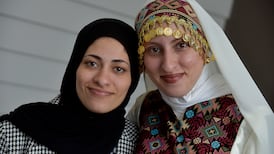After 135 years of being a single-sex school for boys, St Joseph’s on the northside of Dublin was one of several schools that began welcoming girls as a newly co-educational school last week.
Incoming first-year student Jack D’Arcy felt it would be “basically the same” though “because people are people”.
D’Arcy attended an all-boys primary school before, but “had friends who are boys and girls, from a club and from the school across the street”.
Originally a Christian Brothers school when it opened in 1888, St Joseph’s in Fairview was handed over to Edmund Rice in recent years. But it remained an all-boys school
Lacey O’Flaherty, also entering first year, jokes that her only worry about school at St Joseph’s was “opening the locker”, as she had difficulty with it in her first couple of days at the school and she didn’t want to be late for class.
It was not mixing with boys that she worried about, rather “moving to secondary school”.
“I went to a co-ed school before. I liked mixing with boys and girls. I find it the same,” she says.
Originally a Christian Brothers school when it opened in 1888, St Joseph’s in Fairview was handed over to Edmund Rice in recent years. But it remained an all-boys school.
Then it became part of the PTech programme, an industry-led initiative that allows students to integrate elements of degree-level learning and paid work experience in their post-primary education, which is when it became clear that girls were interested in attending.

“The siblings of the boys at our school were interested. They were coming in on open days and the families wanted them to go to the same place,” says principal Séan Stack.
Some of the boys from the primary “started going to other schools in secondary to be with their siblings” too, he says.
“There wasn’t a need for a social change, but it was to do with keeping the families together. A question came up of, ‘well, why wouldn’t you take girls?’ And we didn’t have an answer. Tradition has to have reason,” Stack adds.
The preparation took about 2½ years, Stack says, starting at board of management level, before going on to the school trust and then the Department of Education to assess feasibility.
“But really it starts when you ask what staff and students think. We were lucky enough that at all steps, families were very excited. Staff felt it was a big change, but they believed in it,” Stack says.
The school conducted surveys of its students and the boys’ response was “overwhelmingly positive”.
The Republic has the second highest proportion of single-sex schools in Europe, second only to Malta, and among the highest proportion of single-sex schools globally, outside of the Arab world.
However, the tide appears to be changing as many all-boys and all-girls schools have changed to become co-educational in recent years, and the department has not sanctioned a new single-sex school in 24 years.
Last year, Labour forwarded a Bill that would mean all single-sex primary schools turn co-educational within 10 years and at second level within 15 years
“We’re completely out of kilter with the rest of the world. But more parents are making the move and asking why this legacy remains of the high number of schools which are gender segregated,” says Labour Party education spokesman Aodhán Ó Ríordáin.
Last year, Labour forwarded a Bill that would mean all single-sex primary schools turn co-educational within 10 years and at second level within 15 years.
More schools moving to integrate all genders this year is a “welcome change” Ó Ríordáin says, as he feels there is “no justification anyone can come up with that stands up to any scrutiny that can make sense of the separation of girls and boys. It’s a legacy issue of the past from religious orders. But whenever schools have gone co-ed, it’s been extremely successful.”
Principal of Coláiste Éamann Rís in Co Cork Aaron Wolfe says his school has been doing “brilliantly” since it welcomed boys and girls in 2018.
“There was no English-speaking co-ed secondary school at the time in Cork city. We don’t see co-ed as replacing single-sex education, but we think parents should have choice,” he says.
In its first year, the school welcomed only 16 girls, but they “arrived and made the school their own within a couple [of] hours of being there”. Now the school is about 50-50 boys and girls.
“They are fine with it and settled in straight away,” Wolfe says. “It was us at the time, who had taught all boys for years, and had kind of built it up in our heads”.
They are “both much the same”, he adds. And research backs him up.
An analysis of data from nearly 5,000 15-year-olds in Ireland, published earlier this year, found there is “no academic advantage” for teenagers attending single-sexed or mixed-sex schools. The research examined the association between attending a single-sex school and performance in maths, reading and science.
This result was found for both boys and girls. The research, published in the British Educational Research Journal, echoes findings from the Economic and Social Research Institute and elsewhere indicating that “school effectiveness” rather than gender has a bigger impact on student outcomes.
Teenagers who moved to co-ed schools this year were glad to have “subject choices were better than those offered in an all-girls school”, says Ruby McCluskey who hasn’t been fazed by being outnumbered hugely by boys at St Joseph’s Secondary School in Drogheda, which has also opened its doors to girls for the first time in its 165-year history.
Two of the new girls agreed that it was subject choices that made them opt to enrol as one of the first female students
Almost 60 first-year women and 10 girls who joined higher years at the school last week mingled with 900 boys attending the predominantly male Drogheda school.
Two of the new girls agreed that it was subject choices that made them opt to enrol as one of the first female students.
“As well as my core subjects, I chose applied technology and woodwork which aren’t usually offered in a girls’ school. I also chose graphics. They were subjects that I just really wanted to do and will stand to me down the line if I choose a career in architecture or something similar,” McCluskey says.

The 13-year-old from Termonfeckin said she had already settled instantly into the school and was enjoying her new chapter at post-primary level.
“It’s a great school and really fun to be at. Some of the boys from my primary school are here too and I’ve made a lot of new friends already. I don’t feel I’m being treated differently in any way because I’m one of the first girls here, which is great.”
Her former primary school classmate Luca Rooney (13) from Baltray said there were a number of reasons she opted for St Joseph’s, which has nearly 1,000 students on its roll books, but the core reason was because it was now co-educational.
“It’s really welcoming and modern and I have met loads of new friends already. We grew up with boys. So I felt that to go from a mixed primary school to an all-girls school would be a little weird and I think I would end up being a bit awkward around boys if I spent the next six years being educated without them.”
Principal Paul Savage said the school had introduced three Home Economics classes for the first time this year and “there are about one-third of the classes that are boys, which is great to see. A lot of girls have opted to study traditionally male subjects like woodwork and hopefully, this will lead to addressing a gender imbalance in teachers in these subjects in future years.”
At the fee-paying school Rathdown, in Glenageary, south Dublin, which welcomed boys to its senior school for the first time this year, almost 33 per cent of first-year students starting secondary level this year will be boys, following the school’s transition to co-education at junior level last year.
“The school is a lot more dynamic now,” says second-year student Romy Kirwan, who attended the junior school and secondary school before they were mixed.
“I prefer it being mixed, there’s a lot more options for sports. I think having boys in school will change the school for the better. It’s harder to make friends with boys outside of school when we were only a girls school,” she says.
Yann Fassina, who attended a boys’ school before enrolling in Rathdown, joked that going to school was “much less violent” because it was mixed.
But really, he says: “It’s much nicer because people are interested in more things besides football, and there’s more different personalities”.
The school has no boys in sixth year yet, but head girl Nadia Udo-Obong says it would be “good to have that experience of being with boys every day” because “going into third level and work, they’ll be there”.
Deputy head girl Beth Hamilton Felton feels that if she had grown up with [boys] in secondary school, “I’d be a lot more used to how to act around them. When I go into college it’ll be a bit of a culture shock for me having boys there.”




















